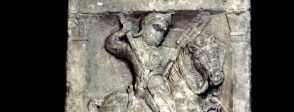The tombstone itself offers plenty of opportunities for initial investigation.
Ask the students what they think the object is made of and what they think it might be. Then help them recognise that the decoration falls into a figure scene and an inscription. Ask them what they think the two parts will contain. Then look at the two sections separately in more detail.
Investigate the scene. Make sure the students recognise the two figures. What do they think is happening? Who do they think is winning and why? Which person do they think the tombstone belongs to and what job do they think he did? You can then move on to the details of Genialis’ armour and weapons, the trappings on his horse, the defeated figure’s sword and nakedness. Look at the Ribchester helmet in For the classroom to compare with how Genialis is shown. Do the students think that he is wearing a helmet like this? Summarise what they have been able to tell so far about Genialis ready for using the inscription to go further.
Look at the inscription first without any additional information. See if the students can recognise anything such as letters and numbers. Try simply to write out the inscription. When they see numbers, ask them what the numbers may mean. Then go through the translation in For the classroom and explore what else the inscription tells us. Were the students right about the numbers?
Use the same process to compare the scene on the tombstone of Facilis from Colchester in For the classroom. These analyses of the tombstones can lead into a wider investigation of the Roman army and the nature of legions and auxiliaries.
Here are some other aspects of the Roman army and of Roman Britain to which you can move out from the tombstone of Genialis.
Look at the objects in A bigger picture. Identify all the different areas of the Roman Empire that can be connected to these objects from Britain and locate them on a map. Which of these soldiers would have felt reasonably at home in Britain? Which soldiers would feel it to be most foreign? There are good writing opportunities for these experiences such as diaries and letters home to the soldiers’ families.
Why was the Roman army so successful? Find out more about the legions and their fighting, tactical and organisational strengths. What did the auxiliaries add to this? What weaknesses of their opponents were the Romans able to exploit? What did the Romans learn from their defeats?
Why was the Roman army important? As well as winning victories and therefore territory, the Roman army was a means of control of the empire. Explore how Roman military forts often became the focus for civilian settlements and the development of Roman towns. You should also explore the role of the army in the growth of local economies, the spread of the Latin language and of religions.
What was Roman about Roman towns? Use the examples of Corinium and Colchester to investigate how towns developed, their layout, buildings and facilities and the extent to which they were different from Iron Age British settlements. This enquiry could lead into a more general question looking at the impact of the Romans on Britain: How Roman was Roman Britain?


